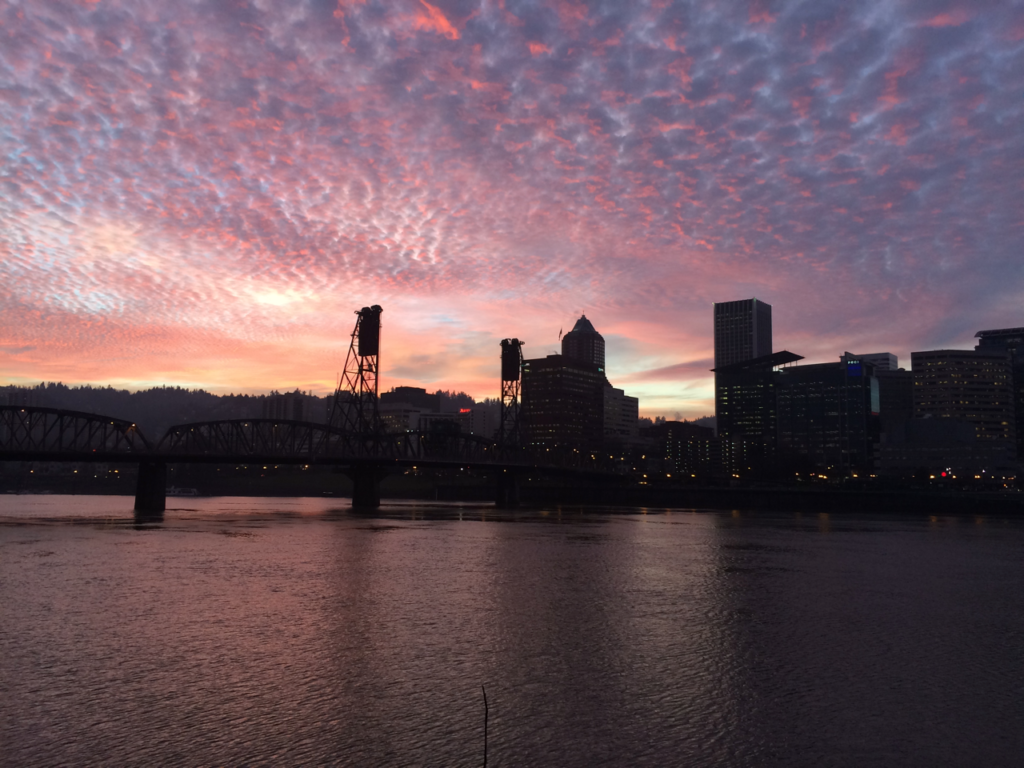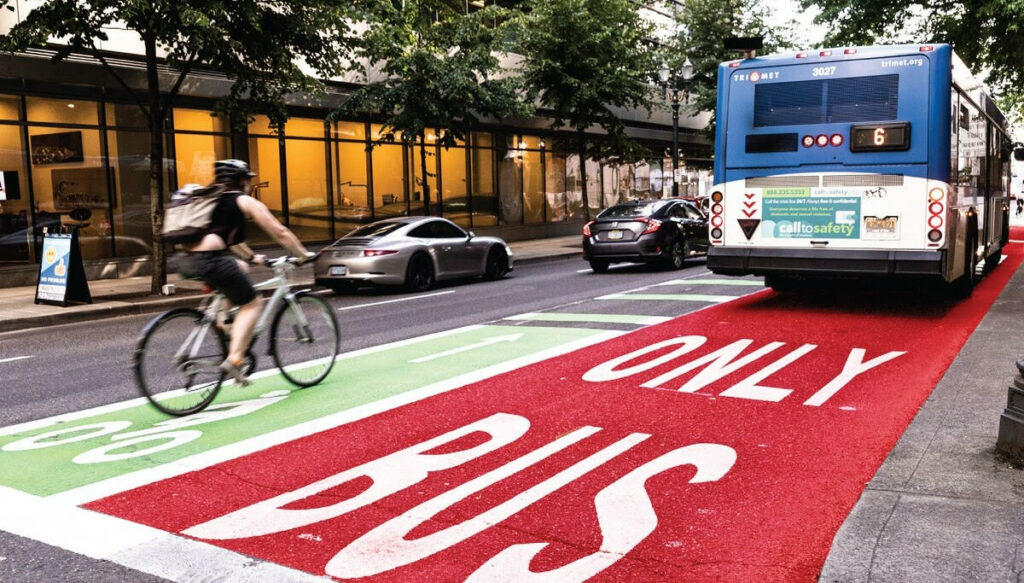by Garlynn Woodsong
Editor’s note:City Observatory is pleased to publish this commentary by Garlynn Woodsong. Garlynn is the Managing Director of the planning consultancy Woodsong Associates, and has more than 20 years of experience in regional planning, urban analytics and real estate development. Instrumental in the development and deployment of the RapidFire and UrbanFootprint urban/regional scenario planning decision-support tools while with Calthorpe Associates in Berkeley, CA, his focus is on making the connections between planning, greenhouse gas emission reductions, public health, and inclusive economic development. For more information, or to contact Garlynn, visit this website.
- The Portland region should rethink its transportation vision and explicitly pursue only projects that reduce greenhouse gas emissions.
- The climate emergency demands a new regional transport authority, with a clear and objective climate test.
- This should be paired with a new regional infrastructure bank featuring a revolving loan fund for both transportation and housing projects, to provide pathways to opportunity for historically oppressed populations.
With the failure of Metro’s 2020 transportation measure at the ballot, it has become clear that the Portland region needs to take a clear, hard look at its transportation system, and how it can manage it to reduce GHG emissions, build out incomplete transit, walking and bicycling infrastructure networks, ensure that critical regional infrastructure maintenance needs are fulfilled, and address historic inequities.
The solutions that could work for Portland certainly could point the way towards models replicable elsewhere; many others regions are also experiencing the same pressures and needs as Portland and Oregon.
Need for Visionary Leadership
First off, what we need, what each place needs to implement these solutions, is visionary leadership: leaders who have the vision to see the enormity of the challenges we face, and to respond appropriately.
These challenges include those related to climate change, such as the need to reduce GHG emissions, to sequester carbon, and to engage in managed retreat from areas at risk of sea level rise or wildfire burn; those related to inequality, such as historic racial and ongoing economic segregation; those related to the economy, such as the impact of COVID-19 on our local businesses, homelessness, and the housing crisis; and those related to sustainability, including the need for municipal fiscal solvency, and access to clean air, water, and energy.
These challenges must be clearly stated as problem statements for strategic planning events where political leaders and senior staff from local jurisdictions and partner agencies are empowered to develop consensus around strategies to achieve solutions as quickly as possible, given the urgency of the overlapping crises we face. These strategies should guide legislative agendas, work programs, and all other related work, so there is no question as to strategic direction or how day-to-day work fits into the puzzle of implementing change for goal achievement.

The vision that is needed to meet the moment and guide the path forward towards a metropolitan region in 2050 where our goals have been achieved must involve three basic elements:
- A well-managed, adequately funded multi-modal transportation system that produces less than 10% of the emissions of our current system by right-sizing roadway capacity to match the lower total VMT that will be needed to attain goals, allowing for greater mobility through zero-emission transit, complete and safe bicycle and pedestrian networks, and the deployment of hi-tech mobility management solutions including on-demand transportation and ride-sharing tools
- An equitable land use system that reduces demand for transportation system elements and energy in ways that are conducive to meeting our climate goals for 2050, by providing plentiful housing and economic opportunities for people of all backgrounds to live in 15-minute neighborhoods.
- A sense of urgency that powers the quick implementation of temporary solutions that can evolve over time in response to lessons learned through deployment, and is facilitated by visionary leadership engaging in enlightened decision-making to deploy strategies and tools quickly that are supportive of every aspect of the vision, such as a carbon tax with an equity kicker that can serve to provide income to populations in need while taxing activities that produce carbon emissions at levels sufficient to bring down those emissions.
We need leaders who can quickly pivot to articulating and implementing this vision, and abandon the efforts that so many current leaders engage in of defending and perpetuating status quo programs that are not designed to deliver components of the vision, and indeed suck resources away from other efforts that could more quickly implement aspects of the vision. We must stop efforts to defend business as usual for government programs, such as highway expansion, that are antithetical to achieving this vision.
Declare a Regional Climate Emergency
One part of the solution is declare a climate emergency, and, using emergency powers, to re-consider all committed TIP and RTP projects, ranking each one by its estimated effectiveness. Any project that results in a net potential increase in GHG emissions must be eliminated from further consideration for funding. Of those that remain, those that should be prioritized for funding include those that will provide the most benefit to historically underserved communities, those that change the design of facilities to ensure safer outcomes, and those that will produce the greatest decrease in GHG emissions, including the build-out of historically under-built modal networks for bicycles, pedestrians, and zero-GHG-emission transit.
The project assessments that are needed to rank projects by their potential effectiveness at reducing GHG emissions and attaining other elements of the vision must be independent of agencies that have a history of pushing a single agenda, such as state transportation departments that evolved from origins as highway departments without ever shedding a single-minded focus on highways as the only solution worth the lion’s share of transportation expenditures. Project assessment must be science-based, evidence-based, and outcomes-based, and not based on results from travel models originally built for the purpose of sizing freeways to accommodate growing automobile traffic. Empirical evidence must replace model results as the gold standard, meaning that places that already embody the principles and elements of the vision should be studied and replicated.
The vision of places that achieve our goals for climate action and for equitable development is of places that are walkable, with most regular destinations accessible by foot within 10 to 15 minutes, and transit available as a pedestrian trip extending tool that allows destinations further away to be accessed. We can achieve this vision by building more such neighborhoods, by building more housing within the 15-minute neighborhoods we already have, and by ensuring that housing is provided that is affordable for people of all incomes, not just those that can be provided for by the profit-dependent sectors of the market. We can cost-effectively achieve no part of this vision by continuing to spend hundreds of millions of dollars widening and expanding our already-over-built highway system.
Regional Transportation Authority
The Portland metro region, like any metropolitan region, contains a network of arterial streets and railroads that are not currently being managed for their highest and best use: there are many ways to potentially measure this, including the maximum amount of movement of people and goods, or the greatest amount of economic activity, or the most general benefit for the most people, for the lowest amount of carbon emissions. However you measure it, the current system is weighted too heavily towards providing room for vehicles that emit large amounts of carbon emissions to transport relatively few people or goods per square foot per hour.
We can look to Translink in Vancouver, B.C.,, and to the Bay Area Toll Authority (BATA) and the Golden Gate Bridge, Highway, and Transportation District in the San Francisco region, for models that show the way towards raising revenue from transportation system operations to pay for the operations, maintenance, expansion, and system completion of bridges, arterial transportation system elements, transit, and regional bicycle and pedestrian facilities including on and off street trails and facilities.
A proposal that is suggested by these examples would be to create and/or vest regional government with the authority to price and manage the regional arterial road, bridge, and trail system, as well as the regional heavy rail system, so that the right of way and facilities could be upgraded using funds from congestion pricing, tolls, and other sources to provide for a complete regional transit and bicycle/pedestrian system, while reducing the automobile capacity of facilities in line with anticipated VMT reduction goals, under a policy framework that places the highest priority on reducing carbon emissions.
The simplest path forward in the Portland region would be to create a new authority, managed by Metro, and given functions now split between ODOT, TriMet, Metro, and the transportation departments/bureaus of the cities and counties within the region. These functions would include those related to operations, management and pricing of the regional arterial road, transit, bicycle, and pedestrian systems.
Regional Infrastructure Bank
To ensure that transport projects play their part in reducing GHG emissions without causing harm to existing communities, a new regional transportation authority should be paired with a complementary new regional infrastructure bank that is empowered with seed funding for a revolving loan fund for building both new links in the transportation system and new homes nearby, to provide pathways to opportunity for historically oppressed populations to build equity and avoid displacement.
Projects needed to achieve regional goals that would be eligible for funding by a new regional Bank could include housing, transportation, or other eligible projects, such as providing seed funding for Local Improvement Districts and Tax Increment Financing efforts that otherwise would face multiple gap years following their initiation until their tax base began producing expected returns, or seed money for a regional revolving housing loan fund accessible by community land trusts, housing cooperatives, and non-profit housing developers.
Urgent Times Require Urgent Action
Finally, Portland’s Rose Lanes project points the way towards a new way of thinking about quick-build-and-deploy projects that can deliver the most benefit as quickly as possible for the least amount of up-front capital.

Could regional Bus Rapid Transit (BRT) systems be quickly deployed using existing rolling stock (at least to start off with), paint, signs, and temporary platforms, so as we all come out of COVID we emerge into a re-structured world that is hyper-focused on reducing GHG emissions as a part of a comprehensive community-building program?
Could regional protected bikeway networks similarly be completed as a part of the same or similar initiatives?
Could regional commuter rail systems be deployed on existing tracks to quickly add center-to-center zero-emission express transit connectivity, such as downtown Portland to downtown Vancouver, WA, much sooner than would otherwise be possible if dependent on traditional 8-12 year capital project delivery schedules?
A Regional Green New Deal
We need to act like our house is on fire, and this thinking needs to permeate every aspect of our collective decision-making processes. We need a Green New Deal locally, regionally, and nationally. Let’s work together to articulate what that means, and how to achieve it. If capital funds are holding us back from achieving that vision, then let’s put forth a funding proposal, such as an equitable carbon tax, that truly matches the moment.
In Portland and Oregon, much of our current success rests on the shoulders of decisions made by visionary leaders of generations past, including the vision to abandon freeway building in favor of light rail, to institute and enforce metropolitan Urban Growth Boundaries, and to embrace downtown revitalization rather than continued suburban sprawl. Portlanders are lucky to have had such visionary past leaders. It is time for the leaders of the current moment, in the Portland region and everywhere else too, to be visionary in articulating solutions to today’s problems, to build on the vision of leaders from years past in ways that advance the goals of protecting farm and forest land, reduce GHG emissions sufficiently to meet our 2050 targets, and build more equitable communities that offer housing opportunities affordable for and economic opportunities available to all residents.
